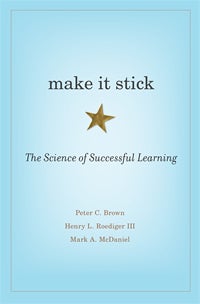
Make It Stick by Peter C. Brown, Henry L. Roediger III, and Mark A. McDaniel (2014) offers many wonderful suggestions about successful learning and teaching. Academic First Year Experiences has hosted several faculty-staff book groups to discuss this text. This page offers additional resources as well as anecdotes from people at CSUN who have "made it stick" by applying the book's principles.
Applications and Anecdotes: How I Made It Stick at CSUN
Have you found ways to Make It Stick at CSUN? Email me (Cheryl) your story and I will add it to my collection (and maybe add it to this webpage as well).
- Melissa Lalum (Faculty Technology Center/Journalism): In the past, I would often concentrate on news writing for a certain amount of time with a course and then move into multimedia storytelling. However, building on the notion of interleaving the practice of different but related topics or skills, I plan on switching between writing and multimedia assignments. The foundation of the assignments remains the same since both require reporting, but the storytelling components (and some technology) are much different. The aspect of this that is compelling to me is that reporters are now often asked to create stories for various platforms out of one event. This ability to move between the two types of storytelling (or "shift gears" as the authors put it) can be quite beneficial in journalism.
- Melissa Lalum (Faculty Technology Center/Journalism): I want to apply reflection in a new way. In addition to turning in a story (no matter what the format), I would have the students also write 1-2 paragraphs reflecting on how the assignment went, where it could be improved, where it might be lacking. While this isn't a new technique, I want to add another component that has them write what the next story on this topic might be (i.e., try to solve a problem before being taught the solution). Basically, through their reflection and questions, they would generate a story idea on unanswered questions or issues that could not be tackled in their current piece. Not only does this help them see where their reporting might be lacking (i.e., help them avoid illusions of knowing), but also they can see how one story builds on another and how it can be used in beat reporting or an investigative series.
- Erin Delaney (English and Academic First Year Experiences) put together a Test Prep PowerPoint (.pptx) for her University 100 class that uses principles from Make it Stick.
Resources and Further Reading
Blodgett, Bonnie. The Blundering Gardener. Website (and blog).
Lang, James M. Making It Stick. Book review. The Chronicle of Higher Education, 23 Apr 2014. This short review may help you decide whether you want to read the whole book. (If you do want to read all of Make It Stick, you can check it out from the AFYE Library in CIELO.)
Stromberg, Joseph. Re-reading is inefficient. Here are 8 tips for studying smarter. Vox. 16 Jan 2015. Blog post (in listicle form). Directed towards a student audience, this post is short and direct. Stromberg interviewed Make It Stick author Mark McDaniel, who distilled some parts of the book. Before you assign the post to your students, watch out for #7 which suggests something that we as faculty ought to be doing. (Thanks to Debbi Mercado at CSUN for this reference.)
Weimer, Maryellen. Using Cumulative Exams to Help Students Revisit, Review, and Retain Course Content. The Teaching Professor Blog, 18 Mar 2015. An immediately useful application of the book's argument that learners need to continue reviewing older material if they wish to retain it. As always, Weimer writes clearly and provides several ways to implement cumulative testing in your classes.
